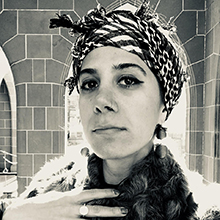Artist Connects Theory with Practice through 3D Modeling
In early 2017, Morehshin Allahyari had been living and working as a permanent resident in the United States when she found herself trapped in Germany after the Trump administration issued an executive order banning entry for citizens from seven Muslim-majority countries, including permanent residents.
"I had my Iranian passport and my green card, but I was stuck in Berlin, not knowing if I could come back or not," said Allahyari (MA '09, digital media studies). "I have lived in the United States for over 10 years, and my whole life is here. It was a really strange moment when I realized how fragile what I have is."
After the ban was eased and she returned to the States, Allahyari drew inspiration from this experience to create the Ya'jooj Ma'jooj figure in her current body of work entitled She Who Sees the Unknown.
"According to the Qur'an, the people of Ya'jooj and Ma'jooj spread mischief and represent chaos, and the people of Zulqarnain asked Allah to build a wall to keep them out. Ya'jooj and Ma'jooj would one day break through the wall and this will be 'the end of days,'" Allahyari explained.
"I fell in love with this story, not only because it related to my personal experience, but also because it represents this notion of chaos. It asks the questions: Who is 'chaos' for whom? Who is barricaded behind which wall?"
She says the story represents a big part of what her project She Who Sees the Unknown is all about—that is embracing the notion of monstrosity, acknowledging prejudices, and reclaiming the power of your oppressors. Through her work, Allahyari "re-figures" how people think about and talk about female or queer figures by retelling their stories using 3D printed models, video, reading rooms, and public performances.
After receiving her BA in social science and media studies from the University of Tehran, Allahyari moved to the United States in 2007 to pursue her master's degree in digital media studies at the University of Denver.
Though Allahyari had previously studied theory, philosophy and critical thinking, she has always had an interest in creative ways to express her ideas and wanted to focus on something more practical in her graduate work.
In a chance encounter, Allahyari met Professor Lynn Clark at a conference in Iran. "It was like a magical moment, because we connected immediately," she said.
She shared with Clark an essay she had been working on about the biased representation of religious versus non-religious women on the Iranian media. Shortly after that, Allahyari and Clark met up again at a conference in Sweden where Clark offered Allahyari a research assistantship working with her at DU.
Moving from Iran, Allahyari had to overcome many obstacles, including feelings of alienation and language barriers, as well as learning new systems and technology.
The digital media studies program at DU offered Allahyari the perfect blend of practice and theory. But it also pushed her out of her comfort zone. The program allowed her to explore and follow her own intuition, while also offering her the opportunity to work with a number of faculty who provided support and mentorship as she developed her own art practice.
"Those two years [at DU] were so important because of [the faculty] and the relationships I had with each of them. They mean a lot to me in so many ways," she said. "Working very closely with Lynn Clark was amazing. I still have so much respect for her and that is something that is always going to stay with me."
"And, Tim Weaver was one of those people, where you could feel very confused about your work, then walk into his office, have the most amazing 30-minute conversation, and walk out feeling inspired," Allahyari recalled. "I know how special that is, now that I have been teaching."
Allahyari said that her faculty mentors helped her understand how to connect theory with practice and think critically about art and technology, all of which can be traced to her current work.
After receiving her MA in digital media studies at DU, Allahyari went on to complete her MFA in new media art at the University of North Texas in 2012. She has been an artist in residence at BANFF Centre (2013); Carnegie Mellon University's STUDIO for Creative Inquiry (2015); Autodesk Pier9 Workshop in San Francisco (2015); the Vilém Flusser Residency Program for Artistic Research in association with Transmediale, Berlin (2016); and Eyebeam's one-year Research Residency in New York (2016–2017).
